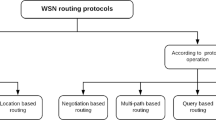Abstract
Effective energy management in heterogeneous wireless sensor networks is more challenging issue compared to homogeneous wireless sensor networks. Much of the existing research focuses on homogeneous wireless sensor networks. The energy conservation schemes for the homogeneous wireless sensor networks do not perform efficiently when applied to heterogeneous wireless sensor networks. The proposed algorithm in this paper exploits the redundancy properties of the wireless sensor networks and also changes the inter cluster communication pattern depending on the energy condition of the high energy nodes during the life cycle of the heterogeneous wireless sensor networks. Performance studies indicate that the proposed algorithm effectively solves the problem of load balancing across the network and is more energy efficient compared to multi hop versions of the standard low energy adaptive clustering hierarchy protocol.
Similar content being viewed by others
References
Baptista, A., Steere, D. C., McNamee, D., Pu, C., & Walpole, J. (2000). Research challenges in environmental observation and forecasting systems. In Proceedings of the 6th annual international conference on Mobile computing and networking (pp. 292–299).
Biagionni, E., & Bridges, K. (2002). The application of remote sensor technology to assist the recovery of rare and endangered species. Special issue on Distributed Sensor Networks for the International Journal of High Performance Computing Applications (pp. 112–121).
Biagionni, E., & Sasaki, G. (2003). Wireless sensor placement for reliable and effficient data collection. In Proceedings of the Hawaiii international conference on systems sciences (p. 127).
Chandrakasan, A., Heinzelman, W. R., & Balakrishnan, H. (2000). Energy-efficient communication protocols for wireless microsensor networks. Hawaii International Conference on System Sciences (pp. 1–10).
Estrin, D., Wang, H., & Girod, L. (2003). Preprocessing in a tiered sensor network for habitat monitoring. EURASIP JASP special issue of sensor networks (pp. 392–401).
Gao, J., Sohrabi, K., Ailawadhi, V., & Pottie, G. (2000). Protocols for self-organization of a wireless sensor network. IEEE Personal Communications Magazine (pp. 16–27).
Govindan, R., & Intanagonwiwat, D. E. C. (2000). Directed diffusion: a scalable and robust communication paradigm for sensor networks. In Proceedings of the 6th annual ACM/IEEE international conference on mobile computing and networking (pp. 56–67).
Gupta, G., & Younis, M. (2003). Load-balanced clustering of wireless sensor networks. IEEE International Conference on Communications (pp. 1848–1852).
Han, C. C., Savvides, A., & Srivastava, M. (2001). Dynamic fine-grained localization in ad-hoc networks of sensors. In The Proceedings of the 7th annual international conference on Mobile computing and networking (pp. 166–179).
Heidemann, J., Bulusu, N., & Estrin, D. (2000). GPS-less low cost out door localization for very small devices. http//www.isi.edu/~johnh/PAPERS/Bulusu00a.pdf.
Heinzelman, W. (2002). Application specific protocol architecture for wireless sensor network. IEEE Transactions on Wireless Communications.
Lin, F., & Du, X. (2005). Desingning efficient routing protocols for heterogeneous sensor networks. 24th IEEE confrence on performance, computing, and communications (pp. 51–58).
Matta, I., Bestavros, A., & Smaragdakis, G. (2004). SEP: a stable election protocol for clustered heterogeneous wireless sensor networks. Second International Workshop on Sensor and Actor Network Protocols and Applications.
Rosenberg, C., & Mhatre, V. (2004). Homogeneous vs heterogeneous clustered sensor networks: a comparative study. IEEE International Conference on Communications (pp. 3645–3651).
Rosenberg, C., & Mhatre, V. P. (2005). A minimum cost heterogeneous sensor network with a lifetime constraint. IEEE Transactions on Mobile Computing (pp. 4–16).
Tian, D., & Georganas, N. D. (2003). A node scheduling scheme for energy conservation in large wireless sensor networks. Wireless Communication and Mobile Computing by Wiley (pp. 271–290).
Wang, X., Akyildiz, I. F., & Wang, W. (2002). Wireless sensor networks: a survey. Computer Networks (pp. 393–422).
Younis, O., & Fahmy, S. (2004). HEED: a hybrid, energy-efficient, distributed clustering approach for ad-hoc sensor networks. IEEE Transactions on Mobile Computing (pp. 366–379).
Zhu, Q., Wang, M., & Qing, L. (2006). Design of a distributed energy-efficient clustering algorithm for heterogeneous wireless sensor networks. Computer Communications by Elsevier (pp. 2230–2237).
Author information
Authors and Affiliations
Corresponding author
Rights and permissions
About this article
Cite this article
Israr, N., Awan, I. Coverage based inter cluster communication for load balancing in heterogeneous wireless sensor networks. Telecommun Syst 38, 121–132 (2008). https://doi.org/10.1007/s11235-008-9099-8
Published:
Issue Date:
DOI: https://doi.org/10.1007/s11235-008-9099-8




